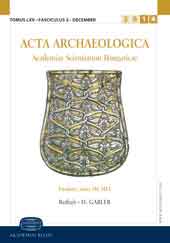Antique meaning — Avar significance complex iconographic schemes on early medieval small objects
Antique meaning — Avar significance complex iconographic schemes on early medieval small objects
Author(s): Gergely SzentheSubject(s): Archaeology
Published by: Akadémiai Kiadó
Keywords: early medieval decorative art; Late Avar animal style; animal combat scene; complex iconographic schemes; interpretatio avarica; culture feeding from its memories;
Summary/Abstract: The goal of the study is to interpret the iconographic schemes of the decorative art of the Carpathian Basin in the early 8th century. The Late Avar animal style is based both on its own pictorial sources and on earlier (that arrived in the Carpathian Basin in the 7th century) and contemporary Mediterranean ones. A Mediterranean trend of the same ornamental topics as the Late Avar animal style can be supposed behind the adapted contemporary Mediterranean elements, which, as the common context of the three groups, created a morphological framework to the formation of a specific ornamental style characteristic of the Carpathian Basin. The probable context is the pictorial program of the (nomadic) elite, which came to a critical position during it’s supposed political marginalisation after the 7th century. The dominance of four-footed predators and animal combat scenes in the patterns of the Late Avar period is a consequence of selection according to an “interpretatio avarica” from the forms of the Mediterranean world. A smaller group of Avar type animal combat scenes and complex iconographic schemes bears a special significance in the local decorative art as traces of a specific culture feeding from its memory. Through this group, the Avars, who had come to a crisis of selfdefinition in result of the marginal position of the Carpathian Basin, were able to create an independent decorative style that allowed the conceptualisation of their identity and aims in a visual language that was also comprehensible in the contemporary Mediterranean.
Journal: Acta Archaeologica Academiae Scientiarum Hungaricae
- Issue Year: 64/2013
- Issue No: 1
- Page Range: 139-172
- Page Count: 34
- Language: English
- Content File-PDF

